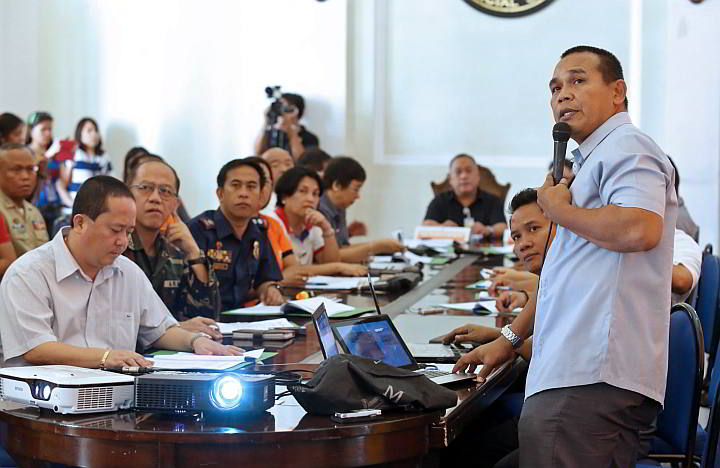
Members of the Provincial Disaster Risk Reduction and Management Office (PDRRMO) with Governor Hilario Davide III (center) and Vice Governor Agnes Magpale listen to Baltazar Tribunalo,(standing right) PDRRMO head as he gives an assessment on the effects of dry spell in the towns. (CDN PHOTO/JUNJIE MENDOZA)
The Cebu provincial disaster council yesterday recommended the declaration of a state of calamity in the entire province.
Below-normal rainfall since March has damaged crops and caused water levels to go down, said Baltazar Tribunalo, Jr., head of the Provincial Disaster Risk Reduction and Management Office.
“The impact of El Niño does not look dramatic but there is a slow onset kind of disaster; it’s creeping,” he said during the council meeting.
A proposed resolution placing the province under a state of calamity will be presented during the Provincial Board session on Monday.
Provincial veterinarian Mary Rose Vincoy said this would speed up the release of P36.6-million in quick response funds from the provincial government’s P121-million disaster fund.
Of the amount, 70 percent is for preparedness while 30 percent is for quick response.
Tribunalo said the municipality of Tuburan in midwest Cebu declared a state of calamity on Tuesday.
READ: Cebu is high risk area for El Niño: Acosta
Twenty other local government units (LGUs) are expected to do the same within the week, he said.
These are Daanbantayan, Tabuelan, Cordova, Argao, Ronda, Moalboal, Alegria, Bogo City, Asturias, Dalaguete, Borbon, Sogod, Santander, Samboan, Alcantara, Malabuyoc, Sibonga, Carcar City, San Fernando and Talisay.
Tribunalo said these LGUs have experienced crop and livestock damage as well as water supply depletion.
In Carcar city in the south, the Can-asujan Dam has dried up, he added.
There are 53 cities and towns in Cebu.
Vincoy said there were reports of poultry deaths in Mandaue City and livestock losses in Camotes last week.
No dry spell yet
Alfredo Quiblat, Jr., officer-in-charge of the Philippine Atmospheric Geophysical and Astronomical Services Administration (Pagasa) Mactan weather station, said Cebu is not yet experiencing a dry spell or drought.
But a dry spell is possible if the below-normal rainfall continues in the next four months, except June.
“Cebu, for the next four to five months, will experience dry spell so on that forecast of Pagasa, we’ll agree to consider the worst scenario,” Quiblat said.
A dry spell occurs when there are three consecutive months of below-normal rainfall or 21 – 60 percent reduction from average rainfall.
READ: State of calamity for 31 upland barangays
A drought occurs when there are three consecutive months of way-below normal rainfall.
Cebu had 34.7 millimeters (mm) of rain in March, a 44.7 percent reduction from the average 62.8 mm rainfall for that month. In April, the deficiency was only 10.4 percent as Cebu had 42.4 mm of rain compared to the 47.3 mm normal rainfall.
Pagasa projected above-normal rainfall in June but below-normal rainfall values from July to September.
Quiblat said Cebu will continue to have partly cloudy skies this week, but with a low chance of rain.
Other areas experiencing below-normal rainfall include Bohol, Negros Oriental, Eastern Visayas and some parts of Mindanao.
Meanwhile, the Metropolitan Cebu Water District reiterated its appeal to the public to conserve and store water during off-peak hours.
Rebecca Husayan, production division manager, said there is a deficit of 16,023 cubic meters of water per day in the entire service area of MCWD.
She assured Vice Governor Agnes Magpale, however, that there will be enough water supply for the hotels that will host Asia Pacific Economic Cooperation (APEC) meetings./With ADMU Intern Shaneika Edryce T. Lim